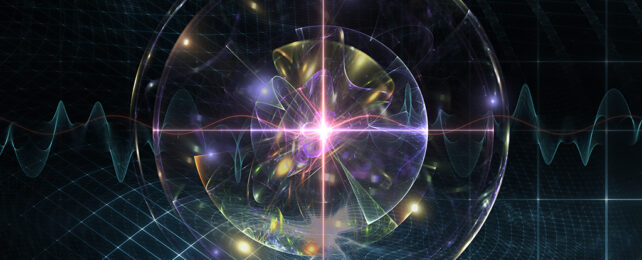With a mass of around three-quarters of our Sun crammed into a ball that could sit comfortably inside Manhattan, the compact object XMMU J173203.3-344518 is certainly remarkable. Weird, even. Maybe bizarre.
But is it strange? A new study by astrophysicists from the University of São Paulo and the Federal University of ABC in Brazil confirms this mind-blowingly dense blob of star stuff might be strange indeed, but perhaps not in the way you might think.
Last year, researchers from the Institute for Astronomy and Astrophysics at the University of Tübingen in Germany reassessed the distance between us and the tiny corpse of a dead star spinning away inside the supernova remnant HESS J1731-347.
A mere 8,150 light-years away, the revised proximity fell short of the previous estimate of roughly 10,000 light-years. The new distance required a recalculation of the compact object's characteristics, particularly its size and mass.
Which is where things got a little exciting.
When stars of a certain mass run out of the kind of fuel their gravity can conveniently crush the daylights out of, they collapse in a cosmic thunderclap of heat and electromagnetism that blows away a proportion of their outer layers.
All that's left is an object so dense its atoms are squeezed cheek to jowl. Deep inside its core, electrons are crammed into their nuclei, forcing protons to lose their charge and transform into neutrons. Congratulations, it's a newborn neutron star.
If there's enough mass, all of that added gravity overcomes critical nuclear forces to crunch matter into something unimaginable, creating a black hole instead. Too little mass, though, and atoms remain friendly neighbors inside what's known as a white dwarf.
That lower mass limit for a neutron star is thought to be just over one solar mass. The lightest detected so far is just 1.17 times the mass of the Sun.
At 77 percent of a solar mass, XMMU J173203.3-344518 isn't merely record-breaking; it's downright confusing. Neutron stars have no business being so petite.
Which implies it might not be a neutron star at all. Speculating it was instead an object called a strange star – consisting mainly of particles known as strange quarks – the researchers left their conclusions for other researchers to kick around.
Picking up where that last study left off, this new investigation returned to the unusually small compact object within HESS J1731-347 and double-checked its mass, radius, and surface temperature.
Comparing their results with strange matter equations and speculative models for their creation in supernovae, the team agreed this weird little object still has all of the hallmarks of a hypothetical strange star.
Quarks are fundamental particles that group in trios to create baryons. Two of the better-known examples of these groups are the nuclear particles protons and neutrons.
Concentrate enough energy in any one spot, and those bundles of quarky goodness can overcome the forces that bind them to arrange into something less structured. Put this hot soup under enough pressure, and its quarks might present as a new form of matter altogether called, unsurprisingly, quark matter.
Quarks happen to come in a variety of forms or flavors. 'Up' and 'down' flavors mix and match to form protons and neutrons. With sufficient pressure, down quarks can transform into up quarks, which in turn can switch into another flavor – a strange quark.
Just how a super compact object made mostly of strange quarks emerges from a supernova isn't clear yet, though some models suggest quark matter typically evolved right from the start of the collapse.
Under fairly unique conditions, something causes this matter to dominate, releasing even more energy in the collapse to shake off more mass than usual, leaving that surplus of quarks behind.
Returning to the latest study, its revised estimates of XMMU J173203.3-344518's age and surface temperature, along with the object's radius and tiny mass, are consistent with cooling conditions that hint at its strange composition.
That doesn't mean something more 'normal' can be ruled out. It does give the astronomical community even more reason to turn their telescopes towards XMMU J173203.3-344518 in consideration of it being a landmark case.
As the authors argue, "It is premature to claim any stronger conclusion, although this is an important case and other detections could add to the whole picture."
This research has been accepted in Astronomy and Astrophysics Letters and is currently available on arXiv.
